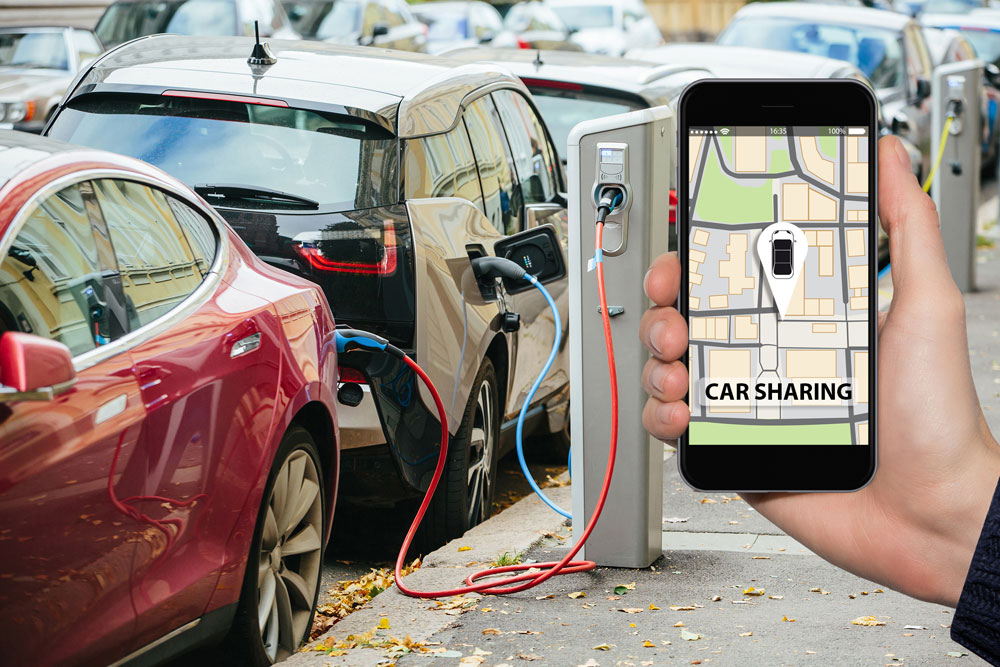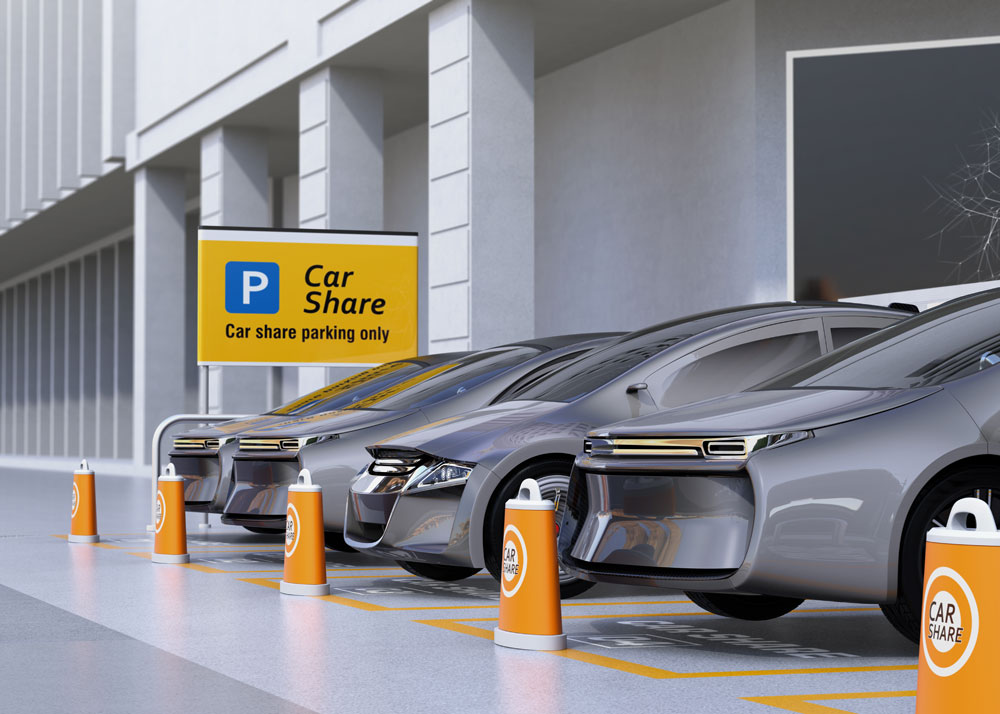


What is Car sharing and how does it work?
Like so many other modern services, car sharing is the offshoot of mobile digitalisation. At its core, car sharing implements the well-known car rental on an individual level and makes it possible to access a vehicle anytime, anywhere. With most sharing models, it is no longer necessary to go to a central rental point; instead, the car can be booked and used directly from the nearest car park. The tariffs and payment models are also much more individual here and usually charge by the minute.
It is so successful because it eliminates the middleman and offers the possibility of booking a car which is available just a few metres away anytime, anywhere. The rental car is closer to the user – the user no longer needs to get to a far-off rental station. Moreover, the billing is so accurate that even the shortest distances are worthwhile for the driver, who would otherwise have to pay a daily or hourly fee to the rental company.
Car sharing is based on the community idea and connects members via App. The App shows all available rental cars in the vicinity. The car is unlocked via PIN or QR-code and can be used for the desired distance. Once the rental is finished all the user has to do is lock the car and leave it in a public parking space.
The next driver can locate the car by App and immediately rent it for his/her own journey. Payment can be based on kilometres driven or minutes used and is charged to the account registered with the App.
This means that city dwellers are as mobile as they like. They do not have to maintain their own car, do not have to worry about the mileage they drive, and refuelling is already included in the car sharing service. Depending on the size and prevalence of the service provider, the nearest available car is usually only a few streets away; metropolitan areas such as Berlin or Hamburg are traditionally better supplied.
Incidentally, this form of sharing was approved by the highest federal authority with the “Law on the Preference of Car Sharing”. This is because the legislator sees car sharing as an opportunity to “particularly reduce the harmful […] effects of motorised private transport on climate and environment.”
Who uses car sharing?
Car sharing first established itself in large cities and gradually spread to the periphery and more rural areas. Most service providers, however, focus on metropolitan areas, where the frequency of use is high, and the target group is large.
Especially in cities owning a car is often a burden. You have to pay for car maintenance on an ongoing basis, but thanks to good public transport systems you hardly need the car at all. Many journeys can be made on foot; often, the car is only used for bulk shopping or longer trips. Moreover, in cities quite often there is a lack of public parking space and if you are out of luck, you only find overpriced parking lots.
More and more people question the cost-benefit ratio of owning a car.
This ratio is a major issue, especially among millennials and subsequent generations. The environmental aspect also gains more and more momentum. Many car sharing providers offer more and more e-vehicles that are low-emission, CO2 neutral and quiet. So, car sharing effectively reduces the particulate matter pollution in cities and users can enjoy the benefits of e-mobility without having to buy a relatively expensive e-vehicle themselves.
What does car sharing cost?
Basically, the cost schemes of all car sharing providers from “drivenow” to “car2go” are similar. When registering for a service, a one-time fee is charged. Upon validation of the driver’s license and installation of the respective App, the user becomes part of the sharing community.
The payment clock only starts ticking when the car is rented by activating a process in the App. It stops as soon as the car is parked and properly locked. Some providers offer flat rates and day packages with mileage included similar to classic rental agencies.
The prices per minute are well below a Euro but are subject to vehicle size. Small cars such as Smart or Mini are usually the entry-level class, but larger sport saloons or vans are offered more and more.
Additional fees or fines are due if the vehicle is reserved far beyond the 20-minute rental term or the user parks in a prohibited zone. Some providers also charge a small fee per rental agreement to buy insurance coverage in case of damage.

Necessary refuelling – be it petrol or electricity – does not need to be paid by the user. If fuel supply goes down, the current user drives to the closest partner filling station. The car can be refuelled free of charge; the fee is charged to the provider. If someone rents an almost empty car and drives straight to the filling station, he/she is rewarded by the service provider, usually by getting extra free minutes which are credited to their account.
When is car sharing worthwhile?
Naturally, those who drive many kilometres a day and are e.g. commuters or sales representatives are not target group for car sharing. This group rather consists of occasional drivers who need a car once in a while in order to undertake a bulk shopping trip or an excursion. Generally, holiday trips and moving to another city are not included in the car sharing scheme.
However, especially smaller start-ups offer vans that are missing from the more established service provider portfolios. These are ideal for shopping in hardware stores or garden centres or when moving to a new place within the city. This makes one thing clear: specifically, for short distances within a city that needs to be spontaneously negotiated by car, the car sharing principle is an excellent alternative to other mobility solutions.

Despite the large number of providers – especially in metropolitan areas – competition is usually restricted to a few large service providers that differ only marginally from each other. Independent suppliers try to position themselves with particularly good terms and conditions and attractive vehicle fleets. This can be beneficial when looking for a certain type of vehicle.
However, as market share increases, so does the spread of vehicles that are also moved more frequently. A strong network of vehicles that can be found and rented spontaneously only a few streets away is one of the best arguments for a provider – not only in one city, but if possible, nationwide.
Admittedly, this also increases the chance that cars will be “sold out” quickly, but the larger the community, the more the provider will invest in new vehicles and the more refuelling stations or service points will become available.
Therefore, double-checking different offers is always worthwhile; it is advisable to compare minute prices, registration fees, vehicle fleet and the small print, before making a decision.
How does car sharing with station loyalty work?
As with rental bicycles there are also car sharing providers who offer their fleet only at certain locations. The vehicles must be returned to the pick-up location at the end of the rental period.
The German national railway organisation, Deutsche Bahn, follows this strategy for both bicycles and cars. Many other independent start-ups also count on this option. What seems to contradict the flexibility of car sharing a little bit at second glance turns out to be an advantage.
Location providers very often have monthly packages on special which make them interesting for frequent drivers who do not own a car. Moreover, there are often special discounts for certain cities and by certain providers for holders of annual or seasonal rail passes.
With fixed locations the probability of incurring fees for improper parking or even towing decreases. Service providers also make sure that their highly frequented stations are always stocked with enough vehicles. Connections to railway stations and other traffic hubs make switching between means of transportation much more convenient.
This comparatively high degree of comfort can be slightly more expensive, but enables more reliable route planning, which is particularly beneficial for business travellers. On the other hand, this sharing model requires a bit more planning and may entail detours.

What about private car sharing?
“My car is your car” is a slogan often seen on platforms that link car owners and drivers. However, these are not just sharing platforms, as already well-known for holiday homes or car-pooling. More accurately, many providers rely on the registered private vehicle to be equipped with respective car sharing technology so that a renter can call up the private vehicle as required.
The platform takes care of the verification of the vehicles on offer and also provides the insurance for the user during the rental period. Owners can determine the price per kilometre themselves and share a percentage with the platform.
Private car sharing becomes ever more popular because real people offer their own cars and can make a bit of extra money as they please. Occasionally, advert prices undercut the prices of commercial providers.
However, the offered vehicles do not necessarily meet the desired standard and are privately used vehicles which show signs of wear and tear and may have special “quirks”. Additionally, they are only available if the owner agrees.
These sharing models may, however, cover areas that are not attractive or profitable enough for large service providers.
Car sharing – a model with a future and role model function?
In the long term car sharing can fulfil legislators’ hopes, especially if e-mobility is more and more established and further developed. Because car sharing is ideal for promoting petrol-free driving.
After all, motorists can try out just how mature the e-drive system has become without having to make a big investment or take on long-term responsibility. Longer distances and ever-more charging stations for e-cars could serve as a model for the entire automotive industry.
On the other hand, however, car sharing should not be seen as the only solution for urban transport problems. Top efficiency and sustainability remain at the hand of the individual and environmentally conscious behaviour can be shown by car-pooling for instance.
Nevertheless, the whole principle of “one car, many drivers” reduces the sheer volume of vehicles in the city. On the other hand, car sharing offers in rural areas would be a possibility to slow down the population decline and ease connections to urban centres.
Even though car sharing has long since ceased to have any news value, it is still far removed from the broad mass markets.

These could, however, also have a positive impact on urban policy. If municipal administrators and sharing providers work together, the alternative to owning a vehicle in the city becomes even more attractive. This could e.g. be translated into tax benefits for the users or a large-scale network of charging stations.
No matter if one wants to share a car or not – car sharing is an ideal starting point to change the way we think about tomorrow’s urban mobility.
STAY IN TOUCH
You are looking for current information, you would like to keep informed about us or you would like to start your career with HUBER?
You are in the right spot:
